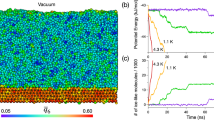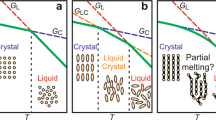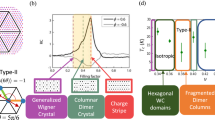Abstract
MELTING of three-dimensional solids usually starts at the free surface, which typically melts at a lower temperature than the bulk material1. In two dimensions the starting point of many studies is the Kosterlitz–Thouless theory2,3, in which melting is initiated through dislocation unbinding. Langmuir mono-layers—single layers of amphiphilic molecules formed at the air-water interface—should provide an ideal model for studying melting in two dimensions. Here we show that for monolayer crystals of fatty acids coexisting with their liquid phase, the interior melts before the edges. The melting of crystals under mechanical stress is initiated along the line at which the internal stress vanishes. We suggest that this apparently counterintuitive result arises from defect migration to the region of zero stress, where they accumulate and nucleate melting. These results support the idea that defects play a crucial role in melting of two-dimensional systems.
This is a preview of subscription content, access via your institution
Access options
Subscribe to this journal
Receive 51 print issues and online access
$199.00 per year
only $3.90 per issue
Buy this article
- Purchase on Springer Link
- Instant access to full article PDF
Prices may be subject to local taxes which are calculated during checkout
Similar content being viewed by others
References
Frenken, J. W. M. & van Pinxteren, H. M. in The Chemical Physics of Solid Surfaces Vol. 7 (eds King, D. A. & Woodruff, D. P.) Ch. 7 (Elsevier, Amsterdam, 1994).
Kosterlitz, J. M. & Thouless, D. J. J. Phys. C 6, 1181–1203 (1973).
Strandburg, K. J. Rev. Mod. Phys. 60, 161–207 (1988).
Bercegol, H., Gallet, F., Langevin, D. & Meunier, J. J. Phys. (France) 50, 2277–2289 (1989).
Bercegol, H. J. Phys. Chem. 96, 3435–3441 (1992).
Bercegol, H. & Meunier, J. Nature 356, 226–228 (1992).
Pershan, P. S. & Als-Nielsen, J. Phys. Rev. Lett. 52, 759–762 (1984).
Flament, C. et al. J. Phys. II (France) 4, 1021–1032 (1994).
Bruinsma, R., Halperin, B. I. & Zippelius, A. Phys. Rev. B 25, 579–582 (1982).
Lifschitz, I. M. & Guilida, L. S. Dokl. Acad. Nauk. 87, 377–380 (1952).
Peach, M. & Koehler, J. S. Phys. Rev. 80, 436–439 (1950).
Pauchard, L. & Meunier, J. Phys. Rev. Lett. 70, 3565–3568 (1993).
Author information
Authors and Affiliations
Rights and permissions
About this article
Cite this article
Pauchard, L., Bonn, D. & Meunier, J. Dislocation-mediated melting of a two-dimensional crystal. Nature 384, 145–147 (1996). https://doi.org/10.1038/384145a0
Received:
Accepted:
Issue Date:
DOI: https://doi.org/10.1038/384145a0
Comments
By submitting a comment you agree to abide by our Terms and Community Guidelines. If you find something abusive or that does not comply with our terms or guidelines please flag it as inappropriate.



